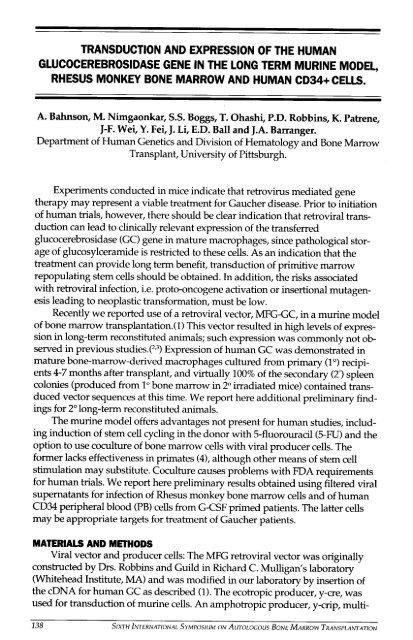VI Autologous Bone Marrow Transplantation.pdf - Blog Science ...
VI Autologous Bone Marrow Transplantation.pdf - Blog Science ...
VI Autologous Bone Marrow Transplantation.pdf - Blog Science ...
You also want an ePaper? Increase the reach of your titles
YUMPU automatically turns print PDFs into web optimized ePapers that Google loves.
TRANSDUCTION AND EXPRESSION OF THE HUMAN<br />
GLUCOCEREBROSIDASE GENE IN THE LONG TERM MURINE MODEL,<br />
RHESUS MONKEY BONE MARROW AND HUMAN CD34+ CELLS.<br />
A. Bahnson, M. Nimgaonkar, S.S. Boggs, T. Ohashi, P.D. Robbins, K. Patrene,<br />
J-F. Wei, Y. Fei, J. Li, E.D. Ball and J.A. Barranger.<br />
Department of Human Genetics and Division of Hematology and <strong>Bone</strong> <strong>Marrow</strong><br />
Transplant, University of Pittsburgh.<br />
Experiments conducted in mice indicate that retrovirus mediated gene<br />
therapy may represent a viable treatment for Gaucher disease. Prior to initiation<br />
of human trials, however, there should be clear indication that retroviral transduction<br />
can lead to clinically relevant expression of the transferred<br />
glucocerebrosidase (GC) gene in mature macrophages, since pathological storage<br />
of glucosylceramide is restricted to these cells. As an indication that the<br />
treatment can provide long term benefit, transduction of primitive marrow<br />
repopulating stem cells should be obtained. In addition, the risks associated<br />
with retroviral infection, i.e. proto-oncogene activation or insertional mutagenesis<br />
leading to neoplastic transformation, must be low.<br />
Recently we reported use of a retroviral vector, MFG-GC, in a murine model<br />
of bone marrow transplantation.(l) This vector resulted in high levels of expression<br />
in long-term reconstituted animals; such expression was commonly not observed<br />
in previous studies.( 23<br />
) Expression of human GC was demonstrated in<br />
mature bone-marrow-derived macrophages cultured from primary (1°) recipients<br />
4-7 months after transplant, and virtually 100% of the secondary (2°) spleen<br />
colonies (produced from 1° bone marrow in 2° irradiated mice) contained transduced<br />
vector sequences at this time. We report here additional preliminary findings<br />
for 2° long-term reconstituted animals.<br />
The murine model offers advantages not present for human studies, including<br />
induction of stem cell cycling in the donor with 5-fluorouracil (5-FU) and the<br />
option to use coculture of bone marrow cells with viral producer cells. The<br />
former lacks effectiveness in primates (4), although other means of stem cell<br />
stimulation may substitute. Coculture causes problems with FDA requirements<br />
for human trials. We report here preliminary results obtained using filtered viral<br />
supernatants for infection of Rhesus monkey bone marrow cells and of human<br />
CD34 peripheral blood (PB) cells from G-CSF primed patients. The latter cells<br />
may be appropriate targets for treatment of Gaucher patients.<br />
MATERIALS AND METHODS<br />
Viral vector and producer cells: The MFG retroviral vector was originally<br />
constructed by Drs. Robbins and Guild in Richard C. Mulligan's laboratory<br />
(Whitehead Institute, MA) and was modified in our laboratory by insertion of<br />
the cDNA for human GC as described (1). The ecotropic producer, y-cre, was<br />
used for transduction of murine cells. An amphotropic producer, y-crip, multi-<br />
138 SIXTH INTERNATIONAL SYMPOSIUM ON AUTOLOGOUS BONE MARROW TRANSPLANTATION

















